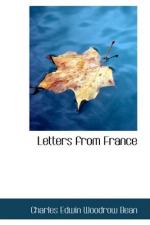[Illustration: The trenches here have to be built above the ground in breastwork and not dug below it]
The trench routine is much the same as it was in Gallipoli, except that in no part which I have seen is the tension anything like so great. At Anzac you were hanging on to the edge of a valley by your finger-nails, and had to steal every yard that you could in order to have room to build up a second line, and if possible a third line beyond that. Here both you and the enemy have scores of miles behind you, and two or three hundred yards more or less makes no difference worth mentioning.
For this reason you would almost say that the German line in this country was asleep compared with the line we used to know. A hundred and fifty yards of green grass, with the skeleton that was once some old hay wagon up-ended in the middle of it, and sky-blue water showing through the grass blades in the depressions; a brown mud wall straggling along the other side of the green—more or less parallel to your breastwork, with white sandbags crowning it like an irregular coping; the inevitable stumpy stakes and masses of rusted barbed wire in front. You might watch it for an hour and the only sign of life you would see would be a blue whiff of smoke from some black tin chimney stuck up behind it. If you fire at the chimney probably it will be taken down. The other day, chancing to look into a periscope, I happened for a moment to see the top of a dark object moving along half hidden by the opposing parapet. Some earth was being thrown up over the breastwork just there, and probably the man had to step round the work which was going on. It was the first and only time I have seen a German in his own lines.
The German here really snipes much more with his field gun than with his rifle. He does use his rifle, too, and is a good shot, but slow. A spout of dust on the parapet—and a periscope has been shattered in the observer’s hand within a few yards of us. But it is generally the German field gun that does his real sniping for him, shooting at any small body of men behind the lines. Half a dozen are quite enough to make a target, if he sees them.
The Turks used to snipe us at times with their field guns and mountain guns, but generally at certain fixed places—down near the mouth of the Aghyl Dere, for example. The German snipes with them more generally. There is no place that I have visited which can compare for perpetual “unhealthiness” to Anzac Beach, but it is quite possible that such places do exist.
The German gives you the impression of being a keener observer than the Turk. The hills and trees behind his lines are really within view of you over miles of your own country, though you scarcely realise it at first, and they are full of eyes. Also every fine day brings out his balloons like a crop of fat grubs—and also our own. In Gallipoli our ships had the only balloons—the Turks had all the hill-tops.




